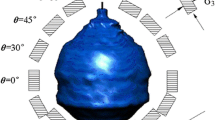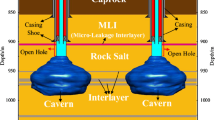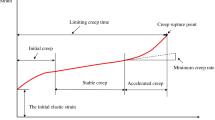Abstract
The presence of interfaces has a critical influence on the stability and tightness of underground gas/oil storages. In China, these energy storages are constructed mainly in bedded salt formations and are widely distributed. Therefore, it is necessary to study the sedimentary rhythm and mechanical characteristics of the interfaces between beds. The petrologic study of core samples from exploratory wells in Yunying Salt Mine, Hubei Provence, China, reveals a sedimentary rhythm and multiple interfaces of bedded salt formations: (1) Mudstone–anhydrite–glauberite–Glauber’s salt–salt rock–mudstone are periodically deposited in sequences. Chemical deposition, the predominant formation mechanism, and mechanical deposition appear alternately and result in the formation of sedimentary multicycles; (2) depending on whether a certain component of the rhythm is lacking or not, interfaces are divided into sequential depositional interfaces and intermittent depositional interfaces. Depending on the deposition frequency, interfaces can also be classified into dominant interfaces and secondary interfaces. Depending on whether the mineral composition changes gradually or abruptly, interfaces can be divided into gradual transition interfaces and discrete discontinuous interfaces. Based on the classification of the interfaces together with scanning electron microscope analyses, the cementation state and strength of the interfaces are discussed. Both field investigations and laboratory tests show that the strengths of the chemical deposition interfaces are higher than those of the mechanical deposition interfaces. Specifically, interfaces of mudstone and rock salt are mostly weak. Taking into account the presence of weak interfaces, the strength of interbedded salt formations around caverns can be represented by a U-shaped lower-bound strength envelope curve, which means that shear failure may occur more easily at the haunches of the cavern. Therefore, when setting the range of the internal operating pressures, more attention should be paid to the shear strength of the weak interlayers and weak interfaces, in particular those at the haunches of the cavern, to ensure the stability and tightness of underground gas/oil stores.


















Similar content being viewed by others
References
Adhikary DP, Dyskin AV (1998) A continuum model of layered rock masses with non-associative joint plasticity. Int J Numer Anal Meth Geomech 22(4):245–261
Aref MAM, Attia OEA, Wali AMA (1997) Facies and depositional environment of the Holocene evaporites in the Ras Shukeir area, Gulf of Suez, Egypt. Sediment Geol 110(1):123–145
Attewell BP, Sandford RM (1974) Intrinsic shear strength of a brittle, anisotropic rock-I: experimental and mechanical interpretation. Int J Rock Mech Min Sci Geomech Abstr 11(11):423–430
Back S, Van Gent H, Reuning L, Groetsch J, Niederau J, Kukla PA (2011) 3D seismic geomorphology and sedimentology of the chalk group, southern Danish North Sea. J Geol Soc 168(2):393–406
Benavente D, Garcia del Cura MA, Garcia-Guinea J, Sanchez-Morald S, Ordonez S (2004) Role of pore structure in salt crystallisation in unsaturated porous stone. J Cryst Growth 260(3–4):532–544
Bérest P, Brouard B (2003) Safety of salt caverns used for underground storage blow out; mechanical instability; seepage; cavern abandonment. Oil Gas Sci Technol 58(3):361–384
Berger A, Herwegh M, Schwarz JO, Putlitz B (2011) Quantitative analysis of crystal/grain sizes and their distributions in 2D and 3D. J Struct Geol 33(12):1751–1763
Bose PK, Eriksson PG, Sarkar S, Wright DT, Samanta P, Mukhopadhyay S, Mandal S, Banerjee S, Altermann W (2012) Sedimentation patterns during the Precambrian: a unique record? Mar Petrol Geol 33:34–68
Charnavel Y, Lubin N (2002) Insoluble deposit in salt cavern--test case. In: Proceedings of the SMRI fall 2002 meeting, Bad Ischl
Cosentino D, Cipollari P, Mastro S, Giampaolo C (2005) High-frequency cyclicity in the latest Messinian Adriatic foreland basin: insight into palaeo climate and palaeo environments of the Mediterranean Lago-Mare episode. Sediment Geol 178:31–53
Crossley NG (1998) Sonar surveys used in gas-storage cavern analysis. Oil Gas J 96(18):96–108
El Tabakh M, Utha-Aroon C, Schreiber BC (1999) Sedimentology of the cretaceous Maha Sarakham evaporites in the Khorat plateau of northeastern Thailand. Sediment Geol 123(1):31–62
Fang ZX, Chen KY, Yang XH, Huang CJ (2003) Sequence stratigraphy characteristic of Qianjiang saline sub-basin. J Salt Lake Res 11(2):14–23 (in Chinese with English abstract)
Glenn CR, Kelts K (1991) Sedimentary rhythms in lake deposits. In: Einsele G, Ricken W, Seilacher A (eds) Cycles and events in stratigraphy. Springer, New York, pp 188–221
Hovorka SD (2000) Characterization of bedded salt for storage caverns: a case study from the midland basin, texas. The University of Texas at Austin, Austin
Hu GM, Ji YL, Zhang YJ (2006) Summarization on continental salt lake sequence stratigraphy. J Salt Lake Res 14(1):55–59 (in Chinese with English abstract)
Hudec MR, Jackson MPA (2007) Terra infirma: understanding salt tectonics. Earth Sci Rev 82(1–2):1–28
Jackson MPA (1995) Retrospective salt tectonics. In: Jackson MPA, Roberts DG, Snelson S (eds) Salt tectonics: a global perspective. AAPG, Tulsa, pp 1–28
Jaeger JC (1960) Shear failure of anisotropic rock. Geol Mag 97:65–72
Kasprzyk A (2003) Sedimentological and diagenetic patterns of anhydrite deposits in the Badenian evaporite basin of the Carpathian Foredeep, southern Poland. Sediment Geol 158(3–4):167–194
Kawamoto E, Shimamoto T (1998) The strength profile for bimineralic shear zones: an insight from high-temperature shearing experiments on calcite–halite mixtures. Tectonophysics 295(1–2):1–14
Kloosterboer-van Hoeve ML, Steenbrink J, Visscher H, Brinkhuis H (2005) Millennial-scale climatic cycles in the early Pliocene pollen record of Ptolemais, Northern Greece. Palaeogeogr Palaeocl 229(4):321–334
Leitner C, Neubauer F, Urai JL, Schoenherr J (2011) Structure and evolution of a rock salt–mudrock–tectonite: the Haselgebirge in the Northern Calcareous Alps. J Struct Geol 33(5):970–984
Li YP, Liu J, Yang CH (2006) Influence of mudstone interlayer on deformation and failure characteristics of salt rock. Chin J Rock Mech Eng 25(12):2461–2466 (in Chinese with English abstract)
Li MH, Kang SC, Zheng MP, Bu LZ (2007) Saline sedimentary rhythm of Qiuli’nanmu Lake in Tibet. Geol J China Univ 13(1):35–42 (in Chinese with English abstract)
Li YP, Yang CH, Qian QH, Wei DH, Qu DA (2007) Experimental research on deformation and failure characteristics of laminated salt rock. In: Proceedings of the 6th conference on the mechanical behavior of salt ‘SALTMECH6’—the mechanical behavior of salt—understanding of THMC processes in salt, Hannover, pp 69–74
Li YP, Jiang WD, Liu J, Chen JW, Yang CH (2007) Direct shear tests for layered salt rocks of Yunying salt mine in Hubei Province. Chin J Rock Mech Eng 26(9):1767–1772 (in Chinese with English abstract)
Li YP, Yang CH, Daemen JJK, Yin XY, Chen F (2009) A new Cosserat-like constitutive model for bedded salt rocks. Int J Numer Anal Meth Geomech. doi:10.1002/nag.784
Liang WG, Yang CH, Zhao YS, Dusseault MB, Liu J (2007) Experimental investigation of mechanical properties of bedded salt rock. Int J Rock Mech Min Sci 44(3):400–411
Liu Q, Xu DM (1979) Classification of potash deposits and its significance for prospecting. Acta Geol Sin 4:351–362 (in Chinese with English abstract)
Makhlouf IM, El-Haddad AA (2006) Depositional environments and facies of the Late Triassic Abu Ruweis formation, Jordan. J Asian Earth Sci 28(4–6):372–384
Mees F (1999) Textural features of Holocene perennial saline lake deposits of the Taoudenni–Agorgott basin, northern Mali. Sediment Geol 127:65–84
Shidahara T, Oyama T, Nakagawa K, Kaneko K, Nozaki A (2000) Geotechnical evaluation of a conglomerate for compressed air energy storage: the influence of the sedimentary cycle and filling minerals in the rock matrix. Eng Geol 56:125–135
Talbot CJ, Jackson MPA (1987) Internal kinematics of salt diapirs. AAPG Bull 71(9):1068–1093
Tzedakis PC (2005) Towards an understanding of the response of southern European vegetation to orbital and suborbital climate variability. Quat Sci Rev 24:1585–1599
Wang QM (2007) Halite deposit and exploration. Chemical Industry Press, Beijing (in Chinese)
Yang CH, Li YP, Chen F, Shi XL, Qu DA (2009) Advances in researches of the mechanical behaviors of deep bedded salt rocks in China. In: Proceedings of the 43rd U.S. rock mechanics symposium and 4th U.S.—Canada rock mechanics symposium, Asheville
Zhang BS, Zhao Z, Han CY, Sun WF, Li Q, Li Hl (2005) Research summary of sequence stratigraphy in salt-lake basin. Northwestern Geol 38(1):94–99 (in Chinese with English abstract)
Acknowledgments
The authors acknowledge the financial support from National Basic Research Program of Science Foundation of China (973 Program) (2009CB724602; 2009CB724603), National Natural Science Foundation of China (51274187).
Author information
Authors and Affiliations
Corresponding author
Rights and permissions
About this article
Cite this article
Zhang, G., Li, Y., Yang, C. et al. Stability and tightness evaluation of bedded rock salt formations for underground gas/oil storage. Acta Geotech. 9, 161–179 (2014). https://doi.org/10.1007/s11440-013-0227-6
Received:
Accepted:
Published:
Issue Date:
DOI: https://doi.org/10.1007/s11440-013-0227-6




